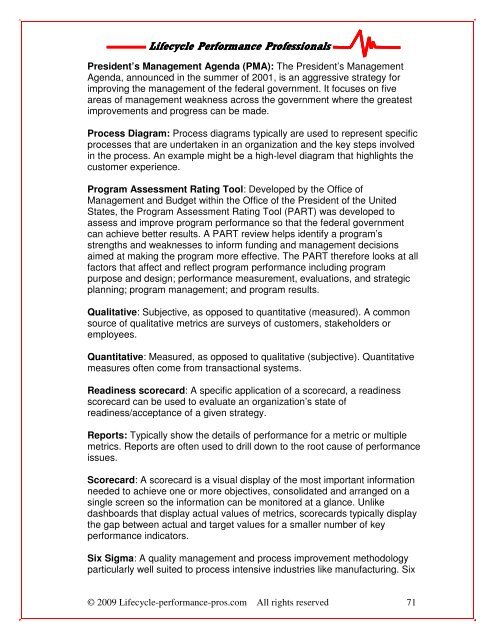Download the Performance Management Fundamentals Guide
Download the Performance Management Fundamentals Guide
Download the Performance Management Fundamentals Guide
Create successful ePaper yourself
Turn your PDF publications into a flip-book with our unique Google optimized e-Paper software.
Lifecycle Lifecycle <strong>Performance</strong> <strong>Performance</strong> Professionals<br />
Professionals<br />
President’s <strong>Management</strong> Agenda (PMA): The President’s <strong>Management</strong><br />
Agenda, announced in <strong>the</strong> summer of 2001, is an aggressive strategy for<br />
improving <strong>the</strong> management of <strong>the</strong> federal government. It focuses on five<br />
areas of management weakness across <strong>the</strong> government where <strong>the</strong> greatest<br />
improvements and progress can be made.<br />
Process Diagram: Process diagrams typically are used to represent specific<br />
processes that are undertaken in an organization and <strong>the</strong> key steps involved<br />
in <strong>the</strong> process. An example might be a high-level diagram that highlights <strong>the</strong><br />
customer experience.<br />
Program Assessment Rating Tool: Developed by <strong>the</strong> Office of<br />
<strong>Management</strong> and Budget within <strong>the</strong> Office of <strong>the</strong> President of <strong>the</strong> United<br />
States, <strong>the</strong> Program Assessment Rating Tool (PART) was developed to<br />
assess and improve program performance so that <strong>the</strong> federal government<br />
can achieve better results. A PART review helps identify a program’s<br />
strengths and weaknesses to inform funding and management decisions<br />
aimed at making <strong>the</strong> program more effective. The PART <strong>the</strong>refore looks at all<br />
factors that affect and reflect program performance including program<br />
purpose and design; performance measurement, evaluations, and strategic<br />
planning; program management; and program results.<br />
Qualitative: Subjective, as opposed to quantitative (measured). A common<br />
source of qualitative metrics are surveys of customers, stakeholders or<br />
employees.<br />
Quantitative: Measured, as opposed to qualitative (subjective). Quantitative<br />
measures often come from transactional systems.<br />
Readiness scorecard: A specific application of a scorecard, a readiness<br />
scorecard can be used to evaluate an organization’s state of<br />
readiness/acceptance of a given strategy.<br />
Reports: Typically show <strong>the</strong> details of performance for a metric or multiple<br />
metrics. Reports are often used to drill down to <strong>the</strong> root cause of performance<br />
issues.<br />
Scorecard: A scorecard is a visual display of <strong>the</strong> most important information<br />
needed to achieve one or more objectives, consolidated and arranged on a<br />
single screen so <strong>the</strong> information can be monitored at a glance. Unlike<br />
dashboards that display actual values of metrics, scorecards typically display<br />
<strong>the</strong> gap between actual and target values for a smaller number of key<br />
performance indicators.<br />
Six Sigma: A quality management and process improvement methodology<br />
particularly well suited to process intensive industries like manufacturing. Six<br />
© 2009 Lifecycle-performance-pros.com All rights reserved 71










